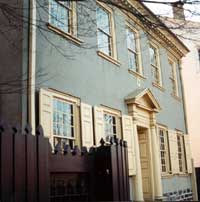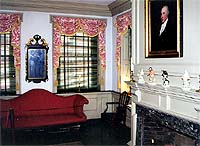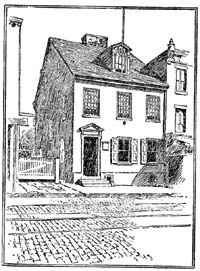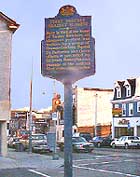Benjamin Franklin's Inventions, Discoveries, and Improvements
Bifocals
College of Optometrists
A modern replica pair of the type of split bifocal spectacles known to have been worn by Benjamin Franklin in the mid 1780s
Bifocals are eyeglasses with an upper and lower half, the upper for distance, and the lower for reading. Bifocals are commonly prescribed to people with presbyopia, a condition that Franklin suffered. Franklin wrote, in August 1784 to his friend George Whatley, that he was "happy in the invention of double spectacles, which serving for distant objects as well as near ones, make my eyes as useful to me as ever they were."
Electricity
Franklin did not, of course, invent electricity, but he discovered many things about it, previously not understood.
Bernard Hoffman
Franklin's Kite Experiment
Before Franklin started his scientific experimentation, it was thought that electricity consisted of two opposing forces. Franklin showed that electricity consisted of a "common element" which he named "electric fire." Further, electricity was "fluid" like a liquid. It passed from one body to another — however it was never destroyed. In a letter to Peter Collinson, Franklin wrote that the "fire only circulates. Hence have arisen some new items among us. We say B (and other Bodies alike circumstanced) are electricised
positively; A
negatively; Or rather B is electricised
plus and A
minus ...
These terms we may use till philosophers give us better."
Franklin's work became the basis for the
single fluid theory. When something is being charged, such as a car battery, electricity flows from a positive body, that with an excess charge, to a negative body, that with negative charge. Indeed, a car battery has plus and minus signs on its terminals.
Franklin wrote Collinson in another letter that: "I feel a Want of Terms here and doubt much whether I shall be able to make this intelligible." Not only did Franklin have to posit theories, he also had to create a new language to fit them. Some of the electrical terms which Franklin coined during his experiments include:
<table width="100%"><tbody><tr><td>
</td><td>
</td><td>
- positively
- negatively
- armature
</td></tr></tbody></table> They are still the terms we use today.
Lightning Rod
Franklin Institute
Rod believed to be an original of Franklin's
Once Franklin had an understanding of the behavior of electricity, he set about to protect houses from the destructive forces of lightning. A lightning rod, simply, is a rod attached to the top of a building, connected to the ground through a wire. The electric charge from lightning strikes the rod and the charge is conducted harmlessly into the ground. This protects houses from burning down and people from electrocution.
Franklin wrote, in 1753
It has pleased God in his goodness to mankind, at length to discover to them the means of securing their habitations and other buildings from mischief by thunder and lightning. The method is this: Provide a small iron rod (it may be made of the rod-iron used by the nailers) but of such a length, that one end being three or four feet in the moist ground, the other may be six or eight feet above the highest part of the building. To the upper end of the rod fasten about a foot of brass wire, the size of a common knitting-needle, sharpened to a fine point; the rod may be secured to the house by a few small staples. If the house or barn be long, there may be a rod and point at each end, and a middling wire along the ridge from one to the other. A house thus furnished will not be damaged by lightning, it being attracted by the points, and passing thro the metal into the ground without hurting any thing. Vessels also, having a sharp point rod fix'd on the top of their masts, with a wire from the foot of the rod reaching down, round one of the shrouds, to the water, will not be hurt by lightning.
Franklin Stove
Franklin's original design for the Franklin stove.
In colonial America, homes were warmed by a fireplace. The Franklin stove, invented in 1742, is a metal-lined fireplace that stands in the middle of a room. It has rear baffles for improved airflow. It provides more heat and less smoke than an open fireplace and uses less wood. This cast-iron furnace would radiate heat from the middle of the room in all directions, and the iron walls even absorbed heat, providing warmth to the room long after the fire went out.
Source: Franklin's Autobiography
In Order of Time I should have mentioned before, that having in 1742 invented an open Stove, for the better warming of Rooms and at the same time saving Fuel, as the fresh Air admitted was warmed in Entring, I made a Present of the Model to Mr. Robert Grace, one of my early Friends, who having an Iron Furnace, found the Casting of the Plates for these Stoves a profitable Thing, as they were growing in Demand. To promote that Demand I wrote and published a Pamphlet Intitled, An Account of the New-Invented pennsylvania fire places: Wherein their Construction and manner of Operation is particularly explained; their Advantages above every other Method of warming Rooms demonstrated; and all Objections that have been raised against the Use of them answered and obviated. &c. This Pamphlet had a good Effect, Govr. Thomas was so pleas’d with the Construction of this Stove, as describ’d in it that he offer’d to give me a Patent for the sole Vending of them for a Term of Years; but I declin’d it from a Principle which has ever weigh’d with me on such Occasions, viz. That as we enjoy great Advantages from the Inventions of others, we should be glad of an Opportunity to serve others by any Invention of ours, and this we should do freely and generously. An Ironmonger in London, however, after assuming a good deal of my Pamphlet, and working it up into his own, and making some small Changes in the Machine, which rather hurt its Operation, got a Patent for it there, and made as I was told a little Fortune by it. And this is not the only Instance of Patents taken out for my Inventions by others, tho’ not always with the same Success: which I never contested, as having no Desire of profiting by Patents my self, and hating Disputes. The Use of these Fireplaces in very many Houses both of this and the neighbouring Colonies, has been and is a great Saving of Wood to the Inhabitants.
Mapping the Gulf Stream
Franklin made eight voyages across the Atlantic Ocean (or, as it was known then, the Western Ocean) between the Colonies and Europe. He wondered why journeys eastward were faster than return trips. His curiosity led him to be the first to map the Gulf Stream. The Gulf Stream, along with the North Atlantic Drift, is the ocean current that originates in the Gulf of Mexico, exits through the Strait of Florida, and follows the eastern coastlines of the United States and Newfoundland before crossing the Atlantic Ocean.
Here is Franklin's original map of the Gulf Stream.
Swim Fins
<table><tbody><tr><td> Benjamin Franklin was an avid swimmer from a very young age. Throughout his life he consistently promoted its healthful benefits. At the ripe old age of 11 he invented a pair of swim fins. However, unlike today's foot flippers, these were attached to one's hands. His advocacy for swimming was recognized by his induction into the International Swimming Hall of Fame in 1968.
Franklin wrote, in March 1773
When a youth, I made two oval pallets, each about ten inches long, and six broad, with a hole for the thumb, in order to retain it fast in the palm of my hand. They much resembled a painter's pallets. In swimming I pushed the edges of these forward, and I struck the water with their flat surfaces as I drew them back. I remember I swam faster by means of these pallets, but they fatigued my wrists. I also fitted to the soles of my feet a kind of sandals, but I was not satisfied with them, because I observed that the stroke is partly given by the inside of the feet and the ankles, and not entirely with the soles of the feet.
</td><td style="padding-left:15px;" valign="top">
Swim fins by Frenchman Louis de Corlieu, in 1933, similar in concept to Franklin's invention.
</td></tr></tbody></table>
Glass Armonica
A popular entertainment in England in the early 18th century was playing music on upright wine goblets, with tones made by rubbing one's fingers around the lip of glasses filled with different quantities of fluid. In 1761, Franklin created a mechanized version, and called it the Armonica (after the Italian word for
harmony.) Franklin worked with London glassblower Charles James to build his Armonica, and it had its world premiere in early 1762, played by Marianne Davies.
Franklin's foot-treadle-operated instrument held 37 glass bowls. The musician touched the rims of the bowls with fingered moistened from the water trough. The bowl-rims were color-coded, according to the note. For example, C's are red, D's orange, E's yellow, etc.





















